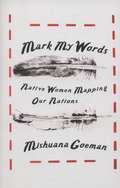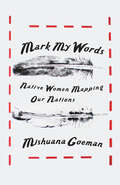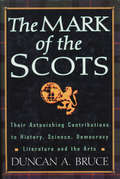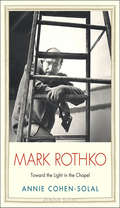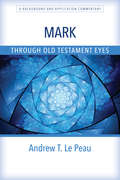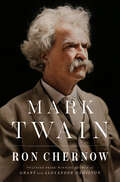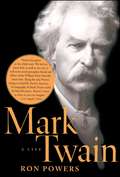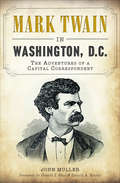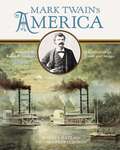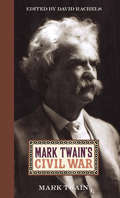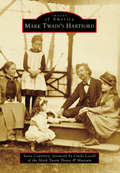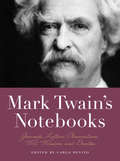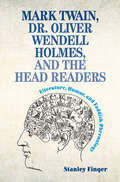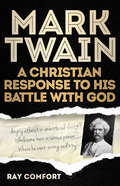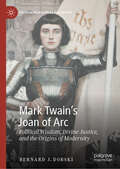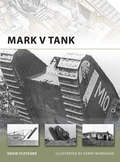- Table View
- List View
Mark My Words: Native Women Mapping Our Nations
by Mishuana GoemanThe book argues that it is vital to refocus the efforts of Native nations beyond replicating settler models of territory, jurisdiction, and race. Through an examination of twentieth-century Native women’s poetry and prose, Goeman illuminates how these works can serve to remap settler geographies and center Native knowledges. She positions Native women as pivotal to how our nations, both tribal and nontribal, have been imagined and mapped, and how these women play an ongoing role in decolonization. In a strong and lucid voice, Goeman provides close readings of literary texts, including those of E. Pauline Johnson, Esther Belin, Joy Harjo, Leslie Marmon Silko, and Heid Erdrich. In addition, she places these works in the framework of U.S. and Canadian Indian law and policy. Her charting of women’s struggles to define themselves and their communities reveals the significant power in all of our stories.
Mark My Words: Native Women Mapping Our Nations (First Peoples: New Directions in Indigenous Studies)
by Mishuana GoemanDominant history would have us believe that colonialism belongs to a previous era that has long come to an end. But as Native people become mobile, reservation lands become overcrowded and the state seeks to enforce means of containment, closing its borders to incoming, often indigenous, immigrants.In Mark My Words, Mishuana Goeman traces settler colonialism as an enduring form of gendered spatial violence, demonstrating how it persists in the contemporary context of neoliberal globalization. The book argues that it is vital to refocus the efforts of Native nations beyond replicating settler models of territory, jurisdiction, and race. Through an examination of twentieth-century Native women&’s poetry and prose, Goeman illuminates how these works can serve to remap settler geographies and center Native knowledges. She positions Native women as pivotal to how our nations, both tribal and nontribal, have been imagined and mapped, and how these women play an ongoing role in decolonization.In a strong and lucid voice, Goeman provides close readings of literary texts, including those of E. Pauline Johnson, Esther Belin, Joy Harjo, Leslie Marmon Silko, and Heid Erdrich. In addition, she places these works in the framework of U.S. and Canadian Indian law and policy. Her charting of women&’s struggles to define themselves and their communities reveals the significant power in all of our stories.
Mark Of The Scots - Cl: Their Astonishing Contributions To History, Science, Democracy, Literature, And The Arts
by Duncan A. BruceHere is the first-ever celebration of all things—and all people—of Scottish descent.While relatively few in number, the Scots have certainly made their mark on the world:· More the seventy-five percent of all American presidents have had Scottish ancestors, although fewer than five percent of the American population is of Scottish descent.· Almost eleven percent of all the Nobel Prizes ever awarded have involved Scots and their descendants—even though fewer than one half percent of the people of the world can claim Scottish ancestry· At least five of the twelve astronauts who have walked on the moon were descended from Scots.Today there are almost 28 million people of Scottish ancestry in the world, over 12 million of whom reside in the United States, about 4 million in Canada, and about 5 million in Scotland. Scottish accomplishments throughout history in every field of endeavor—from science to the arts to politics and exploration—rival those of even the largest ethnic groups:· Scots have been significant in most of the major inventions of the past three centuries, including the steam engine, the telegraph, the telephone, radio, television, the computer, transistor, and the motion picture· People as diverse as Sir Isaac Newton, Charles de Gaulle, Katharine Hepburn, Winston Churchill, Elizabeth Taylor, Immanuel Kant, Sir Laurence Olivier, Elvis Presley, Edvard Grieg, John D. Rockefeller, and Ty Cobb could claim Scottish ancestry· Warsaw, Madrid, La Paz, and Stockholm have all had mayors of Scottish Descent.The Mark of the Scots contains thousands of facts and is fully annotated. It is a comprehensive and readable book that deserves a place on the shelve of every genealogist, Scottish-American, and history buff.
Mark Rothko
by Annie Cohen-SolalMark Rothko, one of the greatest painters of the twentieth century, was born in the Jewish Pale of Settlement in 1903. He immigrated to the United States at age ten, taking with him his Talmudic education and his memories of pogroms and persecutions in Russia. His integration into American society began with a series of painful experiences, especially as a student at Yale, where he felt marginalized for his origins and ultimately left the school. The decision to become an artist led him to a new phase in his life. Early in his career, Annie Cohen-Solal writes, "he became a major player in the social struggle of American artists, and his own metamorphosis benefited from the unique transformation of the U.S. art world during this time." Within a few decades, he had forged his definitive artistic signature, and most critics hailed him as a pioneer. The numerous museum shows that followed in major U.S. and European institutions ensured his celebrity. But this was not enough for Rothko, who continued to innovate. Ever faithful to his habit of confronting the establishment, he devoted the last decade of his life to cultivating his new conception of art as an experience, thanks to the commission of a radical project, the Rothko Chapel in Houston, Texas. Cohen-Solal's fascinating biography, based on considerable archival research, tells the unlikely story of how a young immigrant from Dvinsk became a crucial transforming agent of the art world--one whose legacy prevails to this day.
Mark Through Old Testament Eyes: A Background and Application Commentary (Through Old Testament Eyes)
by Andrew T. Le PeauThrough Old Testament Eyes is a new kind of commentary series that opens the New Testament writings in greater depth to anyone committed to understanding or teaching Scripture. In this inaugural volume, the richness of Old Testament allusions and background in Mark clarifies puzzling passages and explains others in fresh ways.The exodus motif structures Mark. Mark also presents Jesus as the true temple of God in contrast to the existing temple, which has been corrupted. These important themes are hidden to modern eyes without the insight of an Old Testament perspective, and this commentary builds on that insight to emphasize how the gospel applies to the daily lives of Christians today.
Mark Twain
by Ron ChernowPulitzer Prize-winning biographer Ron Chernow illuminates the full, fascinating, and complex life of the writer long celebrated as the father of American literature, Mark Twain. <P> Before he was Mark Twain, he was Samuel Langhorne Clemens. Born in 1835, the man who would become America’s first, and most influential, literary celebrity spent his childhood dreaming of piloting steamboats on the Mississippi. But when the Civil War interrupted his career on the river, the young Twain went west to the Nevada Territory and accepted a job at a local newspaper, writing dispatches that attracted attention for their brashness and humor. It wasn’t long before the former steamboat pilot from Missouri was recognized across the country for his literary brilliance, writing under a pen name that he would immortalize. <P> In this richly nuanced portrait of Mark Twain, acclaimed biographer Ron Chernow brings his considerable powers to bear on a man who shamelessly sought fame and fortune, and crafted his persona with meticulous care. After establishing himself as a journalist, satirist, and lecturer, he eventually settled in Hartford with his wife and three daughters, where he went on to write The Adventures of Tom Sawyer and Adventures of Huckleberry Finn. He threw himself into the hurly-burly of American culture, and emerged as the nation’s most notable political pundit. At the same time, his madcap business ventures eventually bankrupted him; to economize, Twain and his family spent nine eventful years in exile in Europe. He suffered the death of his wife and two daughters, and the last stage of his life was marked by heartache, political crusades, and eccentric behavior that sometimes obscured darker forces at play. <P> Drawing on Twain’s bountiful archives, including thousands of letters and hundreds of unpublished manuscripts, Chernow masterfully captures the man whose career reflected the country’s westward expansion, industrialization, and foreign wars, and who was the most important white author of his generation to grapple so fully with the legacy of slavery. Today, more than one hundred years after his death, Twain’s writing continues to be read, debated, and quoted. In this brilliant work of scholarship, a moving tribute to the writer’s talent and humanity, Chernow reveals the magnificent and often maddening life of one of the most original characters in American history. <b>New York Times Bestseller</b>
Mark Twain
by Ron PowersIf Mark Twain was the seminal American writer, he was also an international celebrity whose life was every bit as extraordinary as his writing. Ron Powers, an award-winning author and critic with twenty years' worth of experience studying Twain and his art, combines enormous learning with wonderful storytelling in a masterful story of the man behind the writing. Twain's story is epic, comic and tragic. To retrace it all in illuminating detail, Powers draws on the tens of thousands of Twain's letters and on his astonishing journal entries - many of which are quoted here for the first time. Twain left Missouri for a life on the Mississippi during the golden age of steamboats, enjoyed an uproariously drunken newspaper career in the Nevada of the Wild West, and witnessed and joined the extremes of wealth and poverty of New York City and of the Gilded Age. Through it all he observed, borrowed, stole and combined the characters he met into the voice of America's greatest literature, attracting throngs of fans wherever his undying lust for wandering took him. From Twain's wicked satire to his relationships with the likes of Ulysses Grant, this is a brilliantly written story that astounds, amuses and edifies as only a great life can.
Mark Twain
by Ron PowersMark Twain founded the American voice. His works are a living national treasury: taught, quoted, and reprinted more than those of any writer except Shakespeare. His awestruck contemporaries saw him as the representative figure of his times, and his influence has deeply flavoured the 20th and 21st centuries. Yet somehow, beneath the vast flowing river of literature that he left behind - books, sketches, speeches, not to mention the thousands of letters to his friends and his remarkable entries in private journals - the man who became Mark Twain, Samuel Langhorne Clemens, has receded from view. It is hard to imagine a life that encompassed more of its times. Sam Clemens left his frontier boyhood in Missouri for a life on the Mississippi during the golden age of steamboats. He skirted the western theater of the Civil War before taking off for an uproariously drunken newspaper career in the Nevada of the Wild West. As his fame as a humorist and lecturer spread, witnessing the extremes of wealth and poverty of New York City and the Gilded Age (which he named). He travelled to Europe on the first American pleasure cruise and revitalized the prim genre of travel writing. He wooed and won his lifelong devoted wife, yet quietly pined for the girl who was his first crush and whom he would re-encounter many decades later. He invented and invested in get-rich-quick schemes. He became the toast of Europe and a celebrity who toured the globe. His comments on everything he saw, many published here for the first time, are priceless. The man who emerges in Powers' brilliant telling is both the magnetic, acerbic, and hilarious Mark Twain of myth and a devoted friend, husband, and father; a whirlwind of optimism and restless energy; and above all, a wide-eared and wide-eyed observer who absorbed every sight and sound, and poured it into his characters, plots, jokes, businesses, and life. Mark Twain offers an unrivalled insight into the life of one of America's greatest writers whose culteral influence was seminal in the creation of modern America.
Mark Twain in Washington, D.C.: The Adventures of a Capital Correspondent
by John MullerA rollicking account of how Mark Twain mocked and mined DC&’s self-important, incompetent, and corrupt political scene to further his literary career. When young Samuel Clemens first visited the nation&’s capital in 1854, both were rough around the edges and of dubious potential. Returning as Mark Twain in 1867, he brought his sharp eye and acerbic pen to the task of covering the capital for nearly a half-dozen newspapers. He fit in perfectly among the other hard-drinking and irreverent correspondents. His bohemian sojourn in Washington, DC, has been largely overlooked, but his time in the capital city was catalytic to Twain&’s rise as America&’s foremost man of letters. While in Washington City, Twain received a publishing offer from the American Publishing Company that would jumpstart his fame. Through original research unearthing never-before-seen material, author John Muller explores how Mark Twain&’s adventures as a capital correspondent proved to be a critical turning point in his career. Includes photos! &“Muller&’s careful research, hard facts, well-chosen illustrations, and fresh discoveries bring Twain&’s Washington period back to life.&” —TwainWeb
Mark Twain's America
by Lewis H. Lapham Library Of Congress Harry L. KatzMark Twain is an American icon. We now know him as the author of classics, but in his day he was a controversial satirist and public figure who traveled the world and healed post-Civil War America with his tall tales, witty anecdotes, and humorous but insightful novels and stories. Twain's legacy continues to flourish over 100 years after his death. MARK TWAIN'S AMERICA features spectacular examples of Twain memorabilia and period Americana from the unsurpassed collections of the Library of Congress: rare illustrations, vintage photographs, popular and fine prints, period views, caricatures, cartoons, maps, and more. Excerpts from Twain's writings are framed in a lively narrative by author Harry L. Katz. Covering the years between 1850 and 1910, the book gives readers an intimate view of Twain's many roles in life: Mississippi river boat pilot, California gold prospector, "printer's devil" at a small-town newspaper, muckraking journalist, novelist, public speaker extraordinaire, our first major celebrity author. Through letters, political cartoons, photographs and more, MARK TWAIN'S AMERICA offers an inside look into Twain's life as well as the literary. social, and political life of America during his time.
Mark Twain's Civil War: The Private History Of A Campaign That Failed
by Mark TwainThis collection of Twain&’s fiction and nonfiction on the subject &“provides insight into the war&’s influence on this great American writer&” (The Post and Courier, Charleston). Had there been no Civil War, the eminent American author known as Mark Twain would likely have spent his life as Sam Clemens, the Mississippi River steamboat pilot. When the war came and the steamboats stopped running, Clemens served two weeks in the Missouri State Guard before he fled west to begin his career as a writer. After the Civil War dramatically altered the course of Twain&’s life and career, his thoughts and stories about the war were published widely. Mark Twain&’s Civil War marks the first opportunity for readers to survey the full range of his Civil War writings in one volume. The book contains autobiographical pieces as well as fiction, making it an enlightening read for both Twain enthusiasts and Civil War scholars.
Mark Twain's Hartford (Images of America)
by Steve Courtney Cindy LovellSamuel L. Clemens, aka Mark Twain, arrived in Hartford, Connecticut, in August 1867. He was there to see the publisher of his new travel book, The Innocents Abroad, and fell in love with the city. "Of all the beautiful towns it has been my fortune to see this is the chief," he wrote to his San Francisco newspaper. At the time, Hartford was a manufacturing, insurance, and banking center. Clemens ultimately settled there, built an ornate mansion, raised a family, made lifelong friends, and took part in civic and political affairs. During his two decades in Hartford, he wrote The Adventures of Tom Sawyer, Adventures of Huckleberry Finn, The Prince and the Pauper, and other works. These were his most productive years--and his happiest--until, as he wrote, Hartford became "the city of heartbreak."
Mark Twain's Letters -- Volume 1 (1853-1866)
by Mark TwainNowhere is the human being more truly revealed than in his letters. Not in literary letters-prepared with care, and the thought of possible publication-but in those letters wrought out of the press of circumstances, and with no idea of print in mind. A collection of such documents, written by one whose life has become of interest to mankind at large, has a value quite aside from literature, in that it reflects in some degree at least the soul of the writer. The letters of Mark Twain are peculiarly of the revealing sort. He was a man of few restraints and of no affectations. In his correspondence, as in his talk, he spoke what was in his mind, untrammeled by literary conventions. Review.
Mark Twain's Letters -- Volume 2 (1867-1875)
by Mark TwainHere is young Sam Clemens—in the world, getting famous, making love—in 155 magnificently edited letters that trace his remarkable self-transformation from a footloose, irreverent West Coast journalist to a popular lecturer and author of The Jumping Frog, soon to be a national and international celebrity. And on the move he was—from San Francisco to New York, to St. Louis, and then to Paris, Naples, Rome, Athens, Constantinople, Yalta, and the Holy Land; back to New York and on to Washington; back to San Francisco and Virginia City; and on to lecturing in Ohio, Michigan, Pennsylvania, and New York. Resplendent with wit, love of life, ambition, and literary craft, this new volume in the wonderful Bancroft Library edition of Mark Twain's Letters will delight and inform both scholars and general readers.
Mark Twain's Letters -- Volume 3 (1876-1885)
by Mark Twain"Don't scold me, Livy—let me pay my due homage to your worth; let me honor you above all women; let me love you with a love that knows no doubt, no question—for you are my world, my life, my pride, my all of earth that is worth the having." These are the words of Samuel Clemens in love. Playful and reverential, jubilant and despondent, they are filled with tributes to his fiancée Olivia Langdon and with promises faithfully kept during a thirty-four-year marriage. The 188 superbly edited letters gathered here show Samuel Clemens having few idle moments in 1869. When he was not relentlessly "banged about from town to town" on the lecture circuit or busily revising The Innocents Abroad, the book that would make his reputation, he was writing impassioned letters to Olivia. These letters, the longest he ever wrote, make up the bulk of his correspondence for the year and are filled with his acute wit and dazzling language. This latest volume of Mark Twain's Letters captures Clemens on the verge of becoming the celebrity and family man he craved to be. This volume has been supported by the National Endowment for the Humanities and by a major donation to the Friends of The Bancroft Library from the Pareto Fund.
Mark Twain's Letters -- Volume 4 (1886-1900)
by Mark TwainAt the beginning of 1870, fresh from the success of The Innocents Abroad, Clemens is on "the long agony" of a lecture tour and planning to settle in Buffalo as editor of the Express. By the end of 1871, he has moved to Hartford and is again on tour, anticipating the publication of Roughing It and the birth of his second child. The intervening letters show Clemens bursting with literary ideas, business schemes, and inventions, and they show him erupting with frustration, anger, and grief, but more often with dazzling humor and surprising self-revelation. In addition to Roughing It, Clemens wrote some enduringly popular short pieces during this period, but he saved some of his best writing for private letters, many of which are published here for the first time.
Mark Twain's Letters -- Volume 5 (1901-1906)
by Mark TwainOn his first trip to England to gather material for a book and cement relations with his newly authorized English publishers, Samuel Clemens was astounded to find himself hailed everywhere as a literary lion. America's premier humorist had begun his long tenure as an international celebrity. Meanwhile, he was coming into his full power at home. The Innocents Abroad continued to produce impressive royalties and his new book, Roughing It, was enjoying great popularity. In newspaper columns he appeared regularly as public advocate and conscience, speaking on issues as disparate as safety at sea and political corruption. Clemens's personal life at this time was for the most part fulfilling, although saddened by the loss of his nineteen-month-old son, Langdon, who died of diphtheria. Life in the Nook Farm community of writers and progressive thinkers and activists was proving to be all the Clemenses had hoped for. The 309 letters in this volume, more than half of them never before published, capture the events of these years with detailed intimacy. Thoroughly annotated and indexed, they are supplemented by genealogical charts of the Clemens and Langdon families, a transcription of the journals Clemens kept during his 1872 visit to England, book contracts, his preface to the English edition of The Gilded Age, contemporary photographs of family and friends, and a gathering of all newly discovered letters written between 1865 and 1871. This volume is the fifth in the only complete edition of Mark Twain's letters ever attempted, and the twenty-fourth in the comprehensive edition known as The Mark Twain Papers and Works of Mark Twain.
Mark Twain's Letters -- Volume 6 (1907-1910)
by Mark TwainMark Twain's letters for 1874 and 1875 encompass one of his most productive and rewarding periods as author, husband and father, and man of property. He completed the writing of The Adventures of Tom Sawyer, published the major collection Sketches, New and Old, became a leading contributor to the Atlantic Monthly, and turned The Gilded Age, the novel he had previously coauthored with Charles Dudley Warner, into one of the most popular comedies of the nineteenth-century American stage. His personal life also was gratifying, unmarred by the family tragedies that had darkened the earlier years of the decade. He and his wife welcomed a second healthy daughter and moved into the showplace home in Hartford, Connecticut, that they occupied happily for the next sixteen years. All of these accomplishments and events are vividly captured, in Mark Twain's inimitable language and with his unmatched humor, in letters to family and friends, among them some of the leading writers of the day. The comprehensive editorial annotation supplies the historical and social context that helps make these letters as fresh and immediate to a modern audience as they were to their original readers. This volume is the sixth in the only complete edition of Mark Twain's letters ever attempted. The 348 letters it contains, many of them never before published, have been meticulously transcribed, either from the original manuscripts (when extant) or from the most reliable sources now available. They have been thoroughly annotated and indexed and are supplemented by genealogical charts, contemporary notices of Mark Twain and his works, and photographs of him, his family, and his friends.
Mark Twain's Notebooks: Journals, Letters, Observations, Wit, Wisdom, and Doodles (Notebook Series)
by Carlo De VitoThis original and insightful collection combines Mark Twain's journal writings with his rarely seen sketches and doodles to create a fascinating, and often hilarious, record of the thoughts, ideas, and observations of the father of American literature. A national treasure and a cultural and literary icon, Mark Twain was called "the father of American literature" by William Faulkner. His beloved works include The Adventures of Huckleberry Finn, Tom Sawyer, and 26 other books. His inimitable prose seamlessly weaves together humor, insight, vivid details, and memorable characters. Along with these published works, Twain, who was also a journalist, produced approximately 40 to 50 pocket notebooks and wrote countless letters, essays, travelogues, and lectures in his lifetime. Mark Twain's Notebooks is the first collection to gather these writings and combine them with dozens of Twain's rarely seen sketches, doodles, and diagrams, as well as facsimiles of his original journal pages, letters, and essays. The result is page after beautifully designed page of some of the best littleknown writings of Mark Twain. Organized by topics such as science, literature, health, family life, and food, the collection also includes intimate letters that describe the home he built in Hartford, Connecticut; his travels across Europe, the Middle East, and the United States; and his agony over the death of his favorite daughter. The writing and art is selected by book and publishing veteran Carlo De Vito, who provides fascinating commentary and insights into the material throughout the book.
Mark Twain, Dr. Oliver Wendell Holmes, and the Head Readers: Literature, Humor, and Faddish Phrenology
by Stanley FingerHaving a phrenological 'head reading' was one of the most significant fads of the nineteenth century – a means for better knowing oneself and a guide for self-improvement. Samuel Clemens (Mark Twain) had a lifelong yet long overlooked interest in phrenology, the pseudoscience claiming to correlate skull features with specialized brain areas and higher mental traits. Twain's books are laced with phrenological terms and concepts, and he lampooned the head readers in Tom Sawyer and Huckleberry Finn. He was influenced by Dr. Oliver Wendell Holmes, who also used his humor to assail head readers and educate the public. Finger shows that both humorists accepted certain features of phrenology, but not their skull-based ideas. By examining a fascinating topic at the intersection of literature and the history of neuroscience, this engaging study will appeal to readers interested in phrenology, science, medicine, American history, and the lives and works of Twain and Holmes.
Mark Twain: A Christian Response to His Battle With God
by Ray ComfortFrom the pages of a long-hidden manuscript written by a man filled with disappointment and anger, you will discover the truth about Mark Twain's embittered battle with God! Evidence in his work that proves he wasn't an atheist Selections from his letters and popular works that reveal his confused faith Perspectives from Twain on God that echo modern criticism and doubts. Twain was a very popular and gifted speaker with a carefully cultivated image. Few knew he secretly wrote a manuscript complaining bitterly about the God of the Bible, citing hypocrisy and cruelties, like there would be no sex in heaven. Twain decided to have his book published 100 years after his death in the hope that society would then be open-minded enough to listen. Ray Comfort searches through volumes of Twain's writings to develop a comprehensive answer to this profound writer of the Adventures of Huckleberry Finn, and a man who suffered much. Discover Twain's arguments with God and a powerful response that helps strengthen your faith and understanding of our loving Creator!
Mark Twain: A Life
by Ron PowersRon Powers's tour de force has been widely acclaimed as the best life and times, filled with Mark Twain's voice, and as a great American story.Samuel Clemens, the man known as Mark Twain, invented the American voice and became one of our greatest celebrities. His life mirrored his country's, as he grew from a Mississippi River boyhood in the days of the frontier, to a Wild-West journalist during the Gold Rush, to become the king of the eastern establishment and a global celebrity as America became an international power. Along the way, Mark Twain keenly observed the characters and voices that filled the growing country, and left us our first authentically American literature. Ron Powers's magnificent biography offers the definitive life of the founding father of our culture.
Mark Twain’s Joan of Arc: Political Wisdom, Divine Justice, and the Origins of Modernity (Recovering Political Philosophy)
by Bernard J. DobskiThis book is about the political wisdom embodied in Personal Recollections of Joan of Arc by Mark Twain, the self-declared best book by arguably America’s greatest author. More precisely, this study illuminates Twain’s political wisdom by examining his approach to the theological-political problem; it takes up Twain’s handling of the question of whether a providential deity intervenes in human affairs so as to effectuate divine justice on earth and it does this through a commentary on his last complete novel. Through this investigation, Twain prompts his audience to explore the natural, conventional, or divine basis for justice in political life. Such a study is critical for understanding Twain’s corpus, concerned as it is with the tension between material determinism and moral agency. Dobski argues that Twain’s last novel prepares his readers to adopt a “new” understanding of man and his relationship to God, his country, and his fellow man.
Mark V Tank
by Henry Morshead David FletcherAlthough to the casual eye all British tanks of World War I look much the same, the Mark V is quite outstanding and has a strong claim to be the tank that won World War I for the Allies. In this title, renowned tank expert David Fletcher examines the technological developments that made this tank excel where others had failed, and the reasons why it gave the British the upperhand over the Germans on the battlefield and why it was adopted by the US Tank Corps. Accompanied by detailed artwork showing the design changes that allowed the Mark V to breach the widest German trenches, this title is an excellent resource for the study of the armor of World War I.
